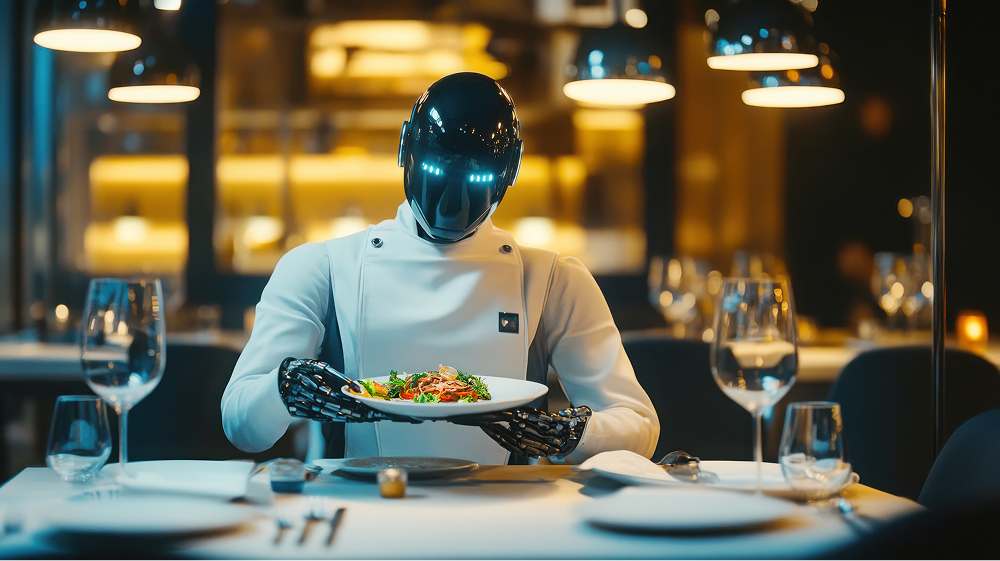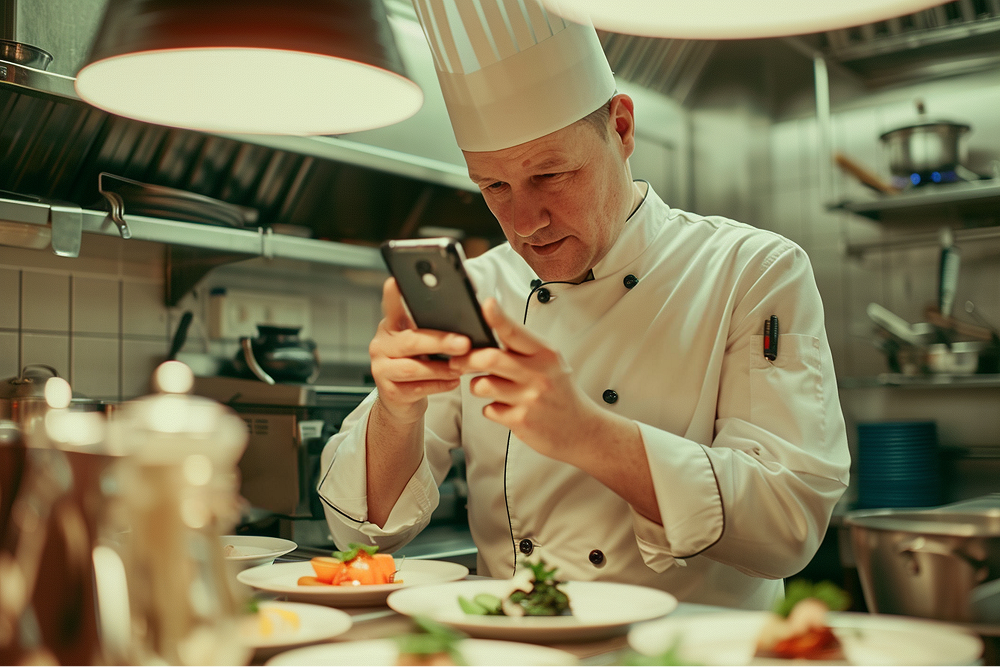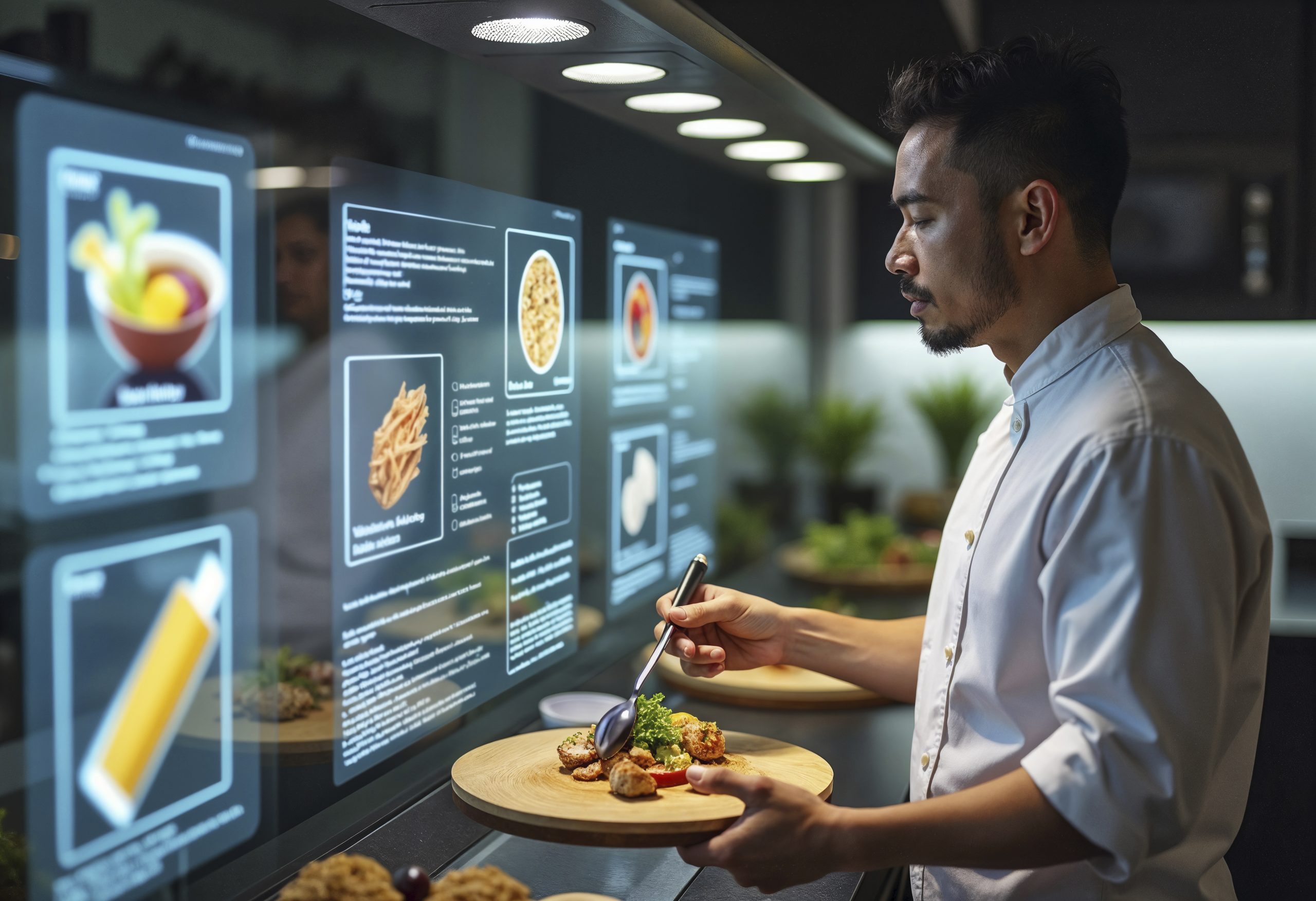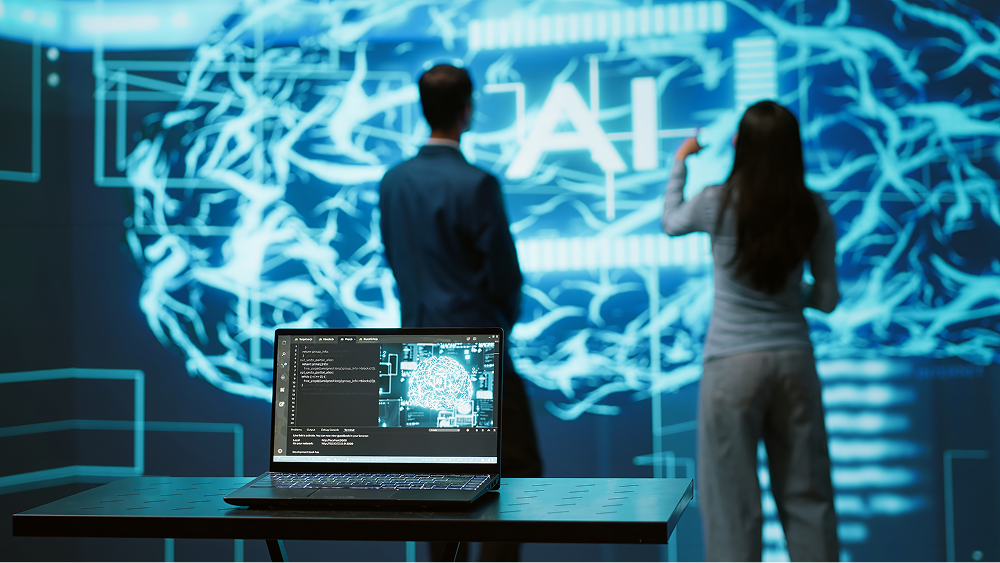Artificial intelligence is quickly transforming the restaurant industry, reshaping how owners serve customers, streamline operations, and drive profits. From AI restaurant ordering systems that reduce wait times to smart tools that help create data-driven menus, AI solutions for restaurants are becoming essential for staying competitive. This developing technology is providing compelling answers, whether you’re trying to understand what an AI restaurant is, where to find the best AI tools for restaurant management, or how AI can help restaurants increase customer satisfaction. AI is now used in restaurant businesses in a variety of ways, from chatbots that take reservations to complex software that forecasts demand and reduces waste. As more restaurants use AI to personalize guest experiences and automate back-of-house tasks, it’s clear that adopting AI isn’t just a trend—it’s the future. Let’s explore the key benefits, practical uses, and how to start using AI in your restaurant today.
What is the role of AI in the restaurant industry?
Artificial intelligence is playing a transformative role in the restaurant industry, changing how businesses operate and connect with customers. From AI-powered restaurant ordering systems to predictive tools that help design profitable menus, AI is streamlining nearly every aspect of the dining experience. Restaurants now use AI for smarter inventory management, dynamic pricing, and even to reduce food waste. AI chatbots manage reservations and provide prompt answers to consumer inquiries, and tailored marketing initiatives increase sales and customer loyalty. AI technologies in the kitchen assist in keeping an eye on cooking times and ensuring constant quality. In addition to increasing efficiency, this expanding application of AI in the restaurant industry also aims to improve customer satisfaction and spur long-term growth. AI solutions for restaurants will keep redefining service standards as technology develops, making operations more creative and customer-focused than before.
How can a restaurant use AI?
- Chatbots for Customer Engagement:
AI chatbots handle reservations, take online orders, answer FAQs, and even recommend dishes based on past visits. This speeds up service and provides customers with quick, helpful responses 24/7. - Computer Vision for Quality and Operations:
Computer vision systems use cameras and artificial intelligence to track inventory, keep an eye on food presentation, and use facial recognition to ensure employee safety. This ensures consistent quality, increases kitchen productivity, and reduces waste. - Predictive Analytics for Smarter Planning:
Using data on local events, sales, and weather, predictive analytics helps predict demand. This allows managers to strategically assign staff, optimize inventory, and modify menus to accommodate customer preferences.
Restaurants can improve customer satisfaction, streamline operations, and maintain their competitiveness in a market that is changing quickly with the help of these AI tools.

What are the benefits of AI in restaurants?
Artificial intelligence is reshaping the restaurant industry by driving smarter, more profitable operations and elevating customer experiences. Here’s how:
- Customization:
AI enables highly personalized dining by analyzing customer data to recommend dishes based on past orders or preferences. This not only delights guests but also boosts sales by suggesting items they’re more likely to try. Additionally, AI-driven loyalty programs and targeted marketing campaigns can increase customer engagement by up to 20%, fostering stronger relationships and repeat visits. - Increased Efficiency:
AI speeds up the entire service process, including order taking, preparation, and payment. By doing this, wait times are shortened and more guests can be served without compromising quality. Order errors are also decreased by automation. AI aids in the creation of the best delivery routes, cutting down on travel time by up to 20% while guaranteeing that food is delivered hot and fresh. - Management and Expense Reduction:
AI makes inventory and supply chain management smarter. It predicts demand, helps maintain optimal ingredient levels, and reduces food waste. Furthermore, such tools can optimize energy use—for example, by adjusting equipment schedules—which reduces utility costs. Automating routine tasks reduces labor costs and directly increases restaurant profitability. - Food Safety and Quality:
Ensuring consistent quality and safety is critical. AI systems keep an eye on prep standards, kitchen hygiene, and food storage temperatures in real time, identifying problems before they become serious ones. This complies with health regulations while preserving premium food quality. According to the National Restaurant Association, AI’s capacity to forecast demand also reduces food waste by as much as 30%. - Reduced Errors:
AI lowers the possibility of mistakes that could result in spoiled ingredients, disgruntled customers, or monetary losses by reducing the amount of manual labor required for repetitive tasks, such as processing reservations, keeping an eye on inventory, or taking orders. In order to ensure seamless and continuous restaurant operations, chatbots precisely confirm reservations and intelligent software quickly detects inventory problems.
For today’s restaurants, integrating AI isn’t just about adopting new tech—it’s about building a smarter, more resilient business that delights customers, cuts unnecessary expenses, and stays ahead in a competitive market.
What are the use cases for AI in various industries?
Telephone Response & Voice-Based Ordering:
AI phone systems can answer calls, respond to common questions, and take reservations—reducing missed calls and freeing up staff. In restaurants, tools like voice-based ordering allow customers to place orders through smart devices or directly with AI assistants at drive-thrus or kiosks, making the process faster and more engaging. For example, Wingstop uses an AI voice assistant to take orders, reducing dropped calls and wait times.
Automated Self-Service Solutions & Self-Serve Options:
AI-powered kiosks and self-serve tablets let customers order, customize meals, and pay at their own pace. Subway’s AI-enabled smart fridge even lets people talk to it to learn about available items. Such tools are popping up in hotels, retail, and healthcare check-ins as well, reducing queues and human resource needs.
Purchasing & Inventory Management:
AI streamlines purchasing by tracking inventory in real-time and automatically placing supplier orders when stock runs low. Predictive analytics also uses sales data to forecast demand, helping avoid overbuying or shortages. This is valuable not just in restaurants but also in manufacturing and e-commerce supply chains.
Timetable & Staffing Management:
AI scheduling software ensures the proper staffing levels while preventing needless labor costs by predicting busy times based on historical data. This enhances the quality of service in restaurants and aids in the effective management of critical staff availability in hospitals and warehouses.
Content Creation & Marketing:
Businesses can save hours of manual writing by using AI tools to create email campaigns, social media posts, and even product descriptions. In order to increase engagement and encourage repeat business, restaurants and retailers use AI to create promotions or customize campaigns based on historical consumer behavior.
Delivery Optimization:
Delivery times can be reduced by up to 20% thanks to AI systems that examine delivery and traffic patterns to determine the quickest routes. These solutions are used by food delivery services and logistics firms to guarantee timely service and lower fuel expenses.
Smart Kitchen & Equipment Management:
AI-driven kitchen systems keep an eye on maintenance requirements, appliance efficiency, and cooking times. Similar systems monitor the operation of machinery in larger industries, such as manufacturing, to prevent malfunctions.
Order Suggestions & Personalized Experiences:
AI uses historical purchase data to tailor recommendations, whether they are for food at a kiosk or goods on an online store. In order to customize the experience for returning customers, KFC has experimented with facial recognition kiosks.
Forecasting & Data Insights:
McDonald’s reduces wait times and increases prep efficiency by using AI to forecast popular menu items and peak ordering times. Retailers use this same predictive modeling to plan seasonal promotions, and airlines use it to determine ticket prices.
Kiosks & Self-Serve Innovations:
Retailers use AI kiosks to help customers find products or get custom recommendations, similar to how some hotels let guests check in with facial recognition.
AI in the back of house
AI is quietly revolutionizing back-of-house operations in restaurants, driving smarter decisions and freeing up staff to focus on exceptional service. Here’s how it’s making a real difference:
Integrated Inventory and Purchasing
Real-time analysis of ingredient usage and sales trends is possible with AI-powered inventory systems that seamlessly integrate with your point of sale system. AI can recommend exactly how much to order by identifying trends in what sells and when, reducing overstocking or the dreaded shortages that force you to settle for 86 popular dishes. By reducing food waste significantly and making sure you only purchase what you’ll use, this strategy preserves your profit margins.
Smarter Staffing and Scheduling
Labor is one of the biggest costs in running a restaurant—and one of the toughest to manage. AI takes the guesswork out of scheduling by analyzing historical sales data alongside local events or even weather forecasts. This helps managers predict busy times and staff up appropriately, preventing long waits while avoiding overstaffing during slower periods.
Data-Based Insights and Predictions
Restaurants are also tapping AI for deep data analysis that goes beyond simple reports. McDonald’s famously used AI to forecast drive-thru demand, shaving 30 seconds off average wait times. Similar predictive tools can anticipate when certain menu items will surge, letting you prep ingredients or run targeted specials to capture demand.
Automated Marketing and Remarketing
AI is also used in marketing. Intelligent systems automatically send texts or emails at the best times to advertise sales or to remind recent visitors to return. Remarketing of this type increases client retention without requiring managers to manually create campaigns.
AI Content Creation
Content is king, but writing takes time. AI tools can generate entire calendars of social media posts, promotional emails, and website updates by pulling from your menu, upcoming events, or customer reviews. This keeps your brand visible and engaging—without adding to your already full plate.
Together, these AI-driven solutions streamline back-of-house operations, reduce waste, lower costs, and support steady growth, giving restaurants the competitive edge they need in a challenging industry.

The Role of AI Agents in the Restaurant Industry
With a degree of intelligent decision-making that surpasses typical automation, AI agents are revolutionizing the way restaurants manage dynamic, daily operations. Managing intricate, multi-step workflows is one strong use case. To ensure that all the ingredients for a dish are ready at the same time, for example, an AI agent can schedule kitchen stations to keep prep moving along with incoming orders. This keeps the line flowing smoothly even during busy times and avoids bottlenecks.
AI agents are also making strides in maintaining operational standards. They can monitor compliance with recipes and preparation methods, learning from real-time data to spot inconsistencies before they affect quality. In multi-location operations, this keeps customer experiences consistent across branches.
Another emerging role is in real-time guest flow management. AI agents analyze table turnover, server workloads, and reservation patterns to adjust seating assignments on the fly. This optimizes floor usage, reducing wait times without overloading staff.
Additionally, as voice and conversational AI advance, AI agents are becoming virtual team members who support staff by answering quick operational questions—like “what’s the current prep time on burgers?”—freeing managers to focus on guests.
Together, these AI-driven capabilities turn restaurants into adaptive systems that respond instantly to shifting conditions, driving smoother service and a better overall dining experience.
Factors to consider before implementing artificial intelligence
Before adopting artificial intelligence in your restaurant, it’s essential to look beyond the excitement and consider several practical factors to ensure a smooth, profitable integration.
What problems are you trying to solve?
Start by identifying specific pain points where AI could add value—whether that’s streamlining order flow, improving guest personalization, or enhancing kitchen consistency. Talking to other restaurateurs already using AI can help you understand what’s realistic and what delivers measurable ROI.
What’s your budget?
AI isn’t a one-time expense. Beyond initial setup costs, there are ongoing fees for software licenses, updates, and potentially new hardware. Make sure you understand the total cost of ownership and have a clear plan for how these investments will pay off.
Is your team ready?
Employee buy-in is crucial. Include your staff early when discussing new tools—ask what challenges they face and how technology could help. Proper training ensures your team uses AI effectively and doesn’t see it as a threat to their roles.
Who will handle implementation and support?
Will you manage the rollout yourself, hire an IT consultant, or rely on the AI provider? Clarify what setup assistance, training, and long-term support are included. Also, plan for periodic system updates as AI technology evolves.
You’ll be in a better position to integrate AI in ways that actually increase productivity and visitor satisfaction if you plan carefully in these areas.
Limitations of AI for restaurants
While AI brings impressive advantages to restaurants, it also comes with clear limitations that operators need to weigh carefully.
- Implementation challenges:
The process of putting artificial intelligence systems into practice can be challenging. It frequently necessitates large expenditures for staff training, hardware, and software. The upfront expenses can be a major deterrent for small eateries, and using these tools efficiently is challenging for those without technical know-how. - The irreplaceable human touch:
No matter how advanced, AI can’t replicate genuine human hospitality. Guests still value warm, personal interactions—something a chatbot or automated ordering system can’t fully deliver. Over Reliance on AI risks making the dining experience feel impersonal. - Staff and customer acceptance:
Employees may worry that AI will replace their jobs, leading to resistance. Guests, too, may hesitate to engage with AI-powered ordering or support, especially older patrons who prefer traditional service. Clear communication and training are essential to overcome this. - AI transparency and trust:
AI often works like a “black box,” making decisions without obvious explanations. This lack of transparency can frustrate staff and customers alike—whether it’s why certain menu items are recommended or how loyalty rewards are determined.
Understanding these limits helps restaurants adopt AI wisely—using it to enhance, not replace, the human elements that make dining out special.
What are the forthcoming trends in the restaurant Industry
Looking ahead, several AI-driven trends are set to shape the restaurant industry in 2025. Voice AI in drive-thrus will become far more common, with systems like Bojangles’ “Bo-Linda” proving that AI can handle upselling, payments, and achieve impressive order accuracy—freeing staff to focus on hospitality. Expect more restaurants to roll out similar voice tech to meet growing demands for faster, hands-free service.
AI-powered personalization is another major trend. With customer data platforms (CDPs) feeding into mobile apps, restaurants will deliver hyper-targeted push notifications, special offers, and loyalty rewards, all tailored to individual preferences. This goes beyond basic email campaigns—AI will dynamically segment audiences and trigger perfectly timed marketing that feels truly personal.
In the kitchen, AI automation will streamline prep and maintain quality. From Chipotle’s automated makelines to White Castle’s voice bots, these solutions will cut waste, save labor, and uphold brand standards. Meanwhile, predictive analytics will see broader adoption, with tools like Winnow helping kitchens forecast demand and slash food waste, driving both sustainability and savings.
Together, these trends signal a shift toward smarter, faster, and more personalized dining—setting new expectations for how restaurants operate and connect with guests.

Who is using AI now
1. Chipotle:
Chipotle uses AI to monitor inventory in real time, predict demand based on traffic patterns and local events, and even automate making tortilla chips with its robot “Chippy.”
2. Starbucks:
Under its “Deep Brew” initiative, Starbucks uses AI to handle inventory orders, predict staffing needs, fine-tune equipment maintenance, and personalize mobile app recommendations, improving both operations and customer experience.
3. Domino’s:
Domino’s began with its voice assistant “Dom” and now uses AI to start prepping pizzas before orders are even completed, cutting delivery times and streamlining its kitchens.
4. White Castle:
White Castle deploys “Julia,” an AI drive-thru bot that takes and processes customer orders with 90% accuracy, reducing staff workload and speeding up service.
5. IHOP:
IHOP leverages Google’s Recommendations AI to personalize online menus, suggesting dishes based on past orders or price preferences, which supports their growing takeout and delivery business.
These brands showcase how AI isn’t just a tech trend—it’s becoming a fundamental part of staying efficient and competitive in today’s restaurant industry.
Conclusion
AI is rapidly transforming the restaurant industry, evolving from an experimental technology into an indispensable tool that helps businesses work smarter and create memorable guest experiences. From predictive analytics that reduce food waste to voice assistants that speed up service, restaurants of all sizes are finding practical and cost-effective ways to integrate AI into their daily processes.However, despite all these advances, the human factor remains key: AI enhances, but does not replace, the hospitality that keeps customers coming back. The most successful restaurants will be those that skillfully combine innovation with genuine, personal service, using AI to free up time and resources so staff can focus on what matters most—creating an exceptional experience for every guest.




